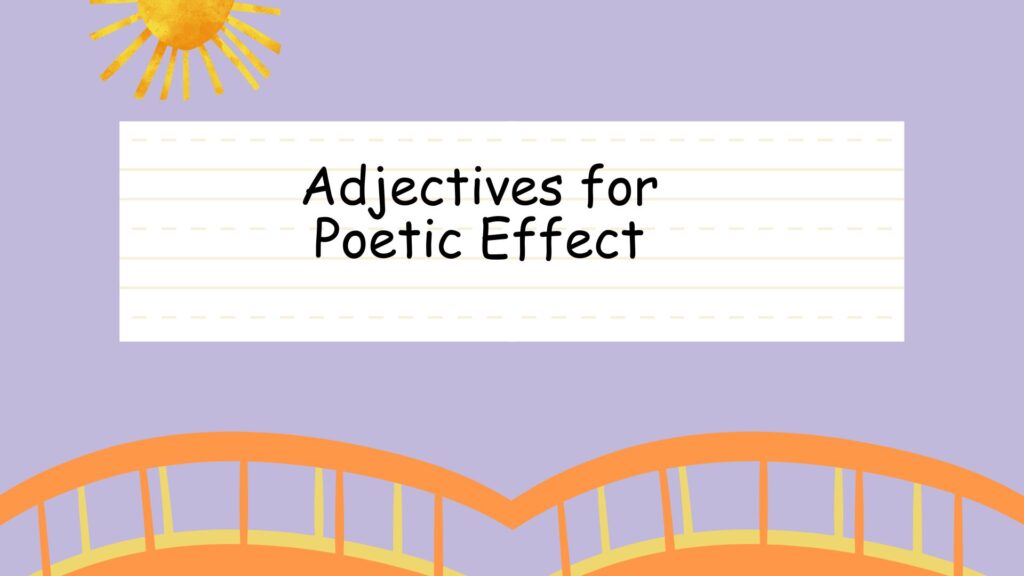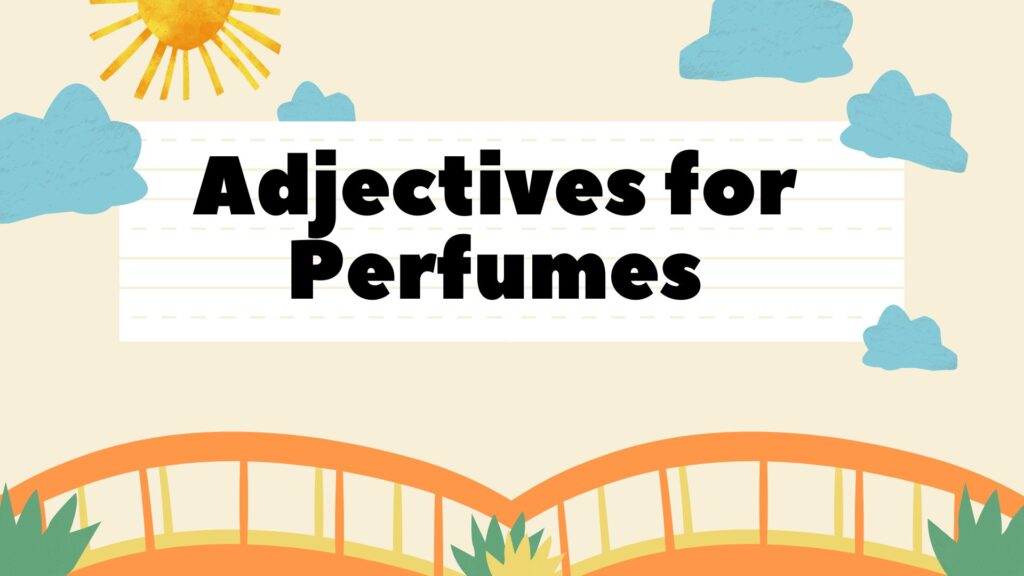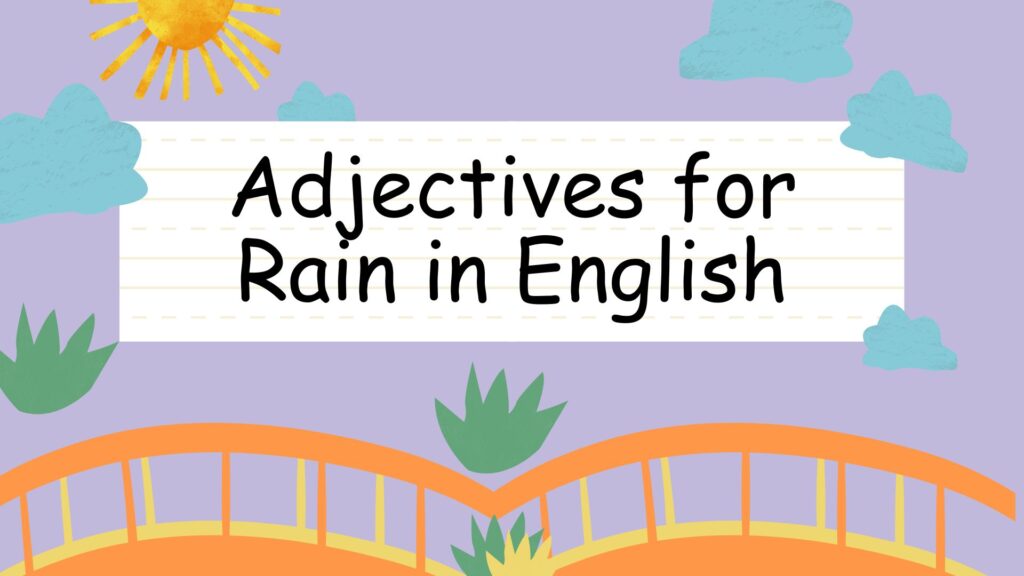Alliteration, the repetition of initial consonant sounds in closely connected words, is a powerful tool in writing and speech. While it’s often associated with tongue twisters and children’s literature, alliteration can add emphasis, rhythm, and a memorable quality to various forms of communication. This article delves into the art of using adjectives for alliteration, exploring how to select the perfect descriptive words to create striking and sonorous phrases. Whether you’re a student, writer, or simply someone who enjoys playing with language, understanding how to wield adjectives for alliteration will enhance your ability to craft compelling and engaging content.
By mastering the art of alliterative adjectives, you can elevate your writing, making it more memorable and impactful. This article provides a comprehensive guide, complete with examples, exercises, and practical tips, to help you harness the power of alliteration in your own creative endeavors.
Table of Contents
- Definition of Alliteration and Adjectives
- Structural Breakdown: How Adjectives Fit into Alliterative Phrases
- Types of Alliteration
- Examples of Adjectives Used in Alliteration
- Usage Rules and Guidelines
- Common Mistakes to Avoid
- Practice Exercises
- Advanced Topics in Alliteration
- Frequently Asked Questions
- Conclusion
Definition of Alliteration and Adjectives
Alliteration is a literary device that involves the repetition of the same consonant sound at the beginning of closely connected words. It’s a stylistic technique used to create a musical effect, emphasize certain words, and make phrases more memorable. The term “alliteration” comes from Latin, meaning “letters of the alphabet.”
An adjective is a word that describes or modifies a noun or pronoun. Adjectives provide details about the qualities, characteristics, or state of being of the nouns they modify. They answer questions like “What kind?”, “Which one?”, or “How many?” When used in alliteration, adjectives contribute to the sound pattern while also enhancing the descriptive power of the phrase.
In the context of this article, we’re focusing specifically on how adjectives can be strategically chosen and employed to create alliterative phrases that are both aesthetically pleasing and semantically rich. The combination of alliteration and well-chosen adjectives amplifies the impact of your writing.
Structural Breakdown: How Adjectives Fit into Alliterative Phrases
The basic structure of an alliterative phrase using adjectives often involves an adjective followed by a noun, both starting with the same consonant sound. However, more complex structures are also possible, including multiple adjectives modifying the same noun, or adjectives modifying different nouns within a single phrase or sentence. The key is to maintain the repetition of the initial consonant sound for a noticeable and effective alliterative effect.
Consider these examples:
- Brave boy (Simple adjective-noun structure)
- Giant green grass (Multiple adjectives modifying a noun)
- The sly snake slid silently. (Adjective, noun, and verb alliteration)
The adjective’s placement is crucial. It usually precedes the noun it modifies, creating a direct and immediate alliterative impact. The sounds should be close enough together to be easily perceived by the reader or listener. The effectiveness of the alliteration depends on the clarity and prominence of the repeated sound.
Types of Alliteration
Alliteration can be categorized based on the placement and frequency of the repeated sounds. Here are some common types:
Initial Alliteration
This is the most common type, where the repeated consonant sound occurs at the beginning of words, as in “silly songs.”
Internal Alliteration
Internal alliteration involves the repetition of consonant sounds within words in a sentence, rather than just at the beginning. For example, “The king’s thinking was unthinkable.” This type is more subtle and can add depth to the sound texture of the writing.
Assonance
Although technically not alliteration (which focuses on consonants), assonance is the repetition of vowel sounds within words. It creates a similar musical effect. An example is “The seat was beaten.”
Consonance
Consonance is the repetition of consonant sounds anywhere within words, not just at the beginning. It can occur in the middle or at the end of words. An example is “The blue bird sang a song.”
While initial alliteration is the primary focus when using adjectives for alliteration, understanding these other types can help you create more nuanced and sophisticated sound patterns in your writing.
Examples of Adjectives Used in Alliteration
The following sections provide extensive examples of adjectives used in alliteration, categorized by their general connotation (positive, negative, and descriptive). These examples illustrate how alliteration can be used to create vivid and memorable phrases.
Positive Adjectives
Positive adjectives enhance the noun they modify with favorable qualities. Using them in alliteration can create an upbeat and pleasing effect.
The table below contains examples of positive adjectives used in alliteration with nouns.
| Adjective | Noun | Example Sentence |
|---|---|---|
| Amazing | Adventures | They embarked on amazing adventures around the world. |
| Beautiful | Blossoms | The garden was filled with beautiful blossoms in the spring. |
| Charming | Cottage | They lived in a charming cottage by the sea. |
| Delightful | Dreams | She had delightful dreams every night. |
| Excellent | Effort | He put in an excellent effort on the project. |
| Fantastic | Feast | They prepared a fantastic feast for the celebration. |
| Generous | Gifts | She received generous gifts from her friends. |
| Harmonious | Hymns | The choir sang harmonious hymns during the service. |
| Incredible | Ideas | He came up with incredible ideas for the company. |
| Joyful | Journey | They embarked on a joyful journey together. |
| Kind | Kids | The teacher was very kind to the kids. |
| Lovely | Laughter | The room was filled with lovely laughter. |
| Marvelous | Memories | They created marvelous memories on their vacation. |
| Nice | Neighbors | They had very nice neighbors in their new town. |
| Outstanding | Offer | She received an outstanding offer for the job. |
| Perfect | Performance | The actor gave a perfect performance on stage. |
| Quaint | Quarters | They stayed in quaint quarters during their trip. |
| Radiant | Roses | The garden was full of radiant roses. |
| Splendid | Sunset | They watched a splendid sunset over the ocean. |
| Terrific | Team | The coach built a terrific team this year. |
| Unique | Understanding | The professor showed a unique understanding of the subject. |
| Vibrant | Visions | The artist had vibrant visions for the future. |
| Wonderful | World | They explored a wonderful world of possibilities. |
| Zealous | Zebras | The young zoologist was zealous about protecting the zebras. |
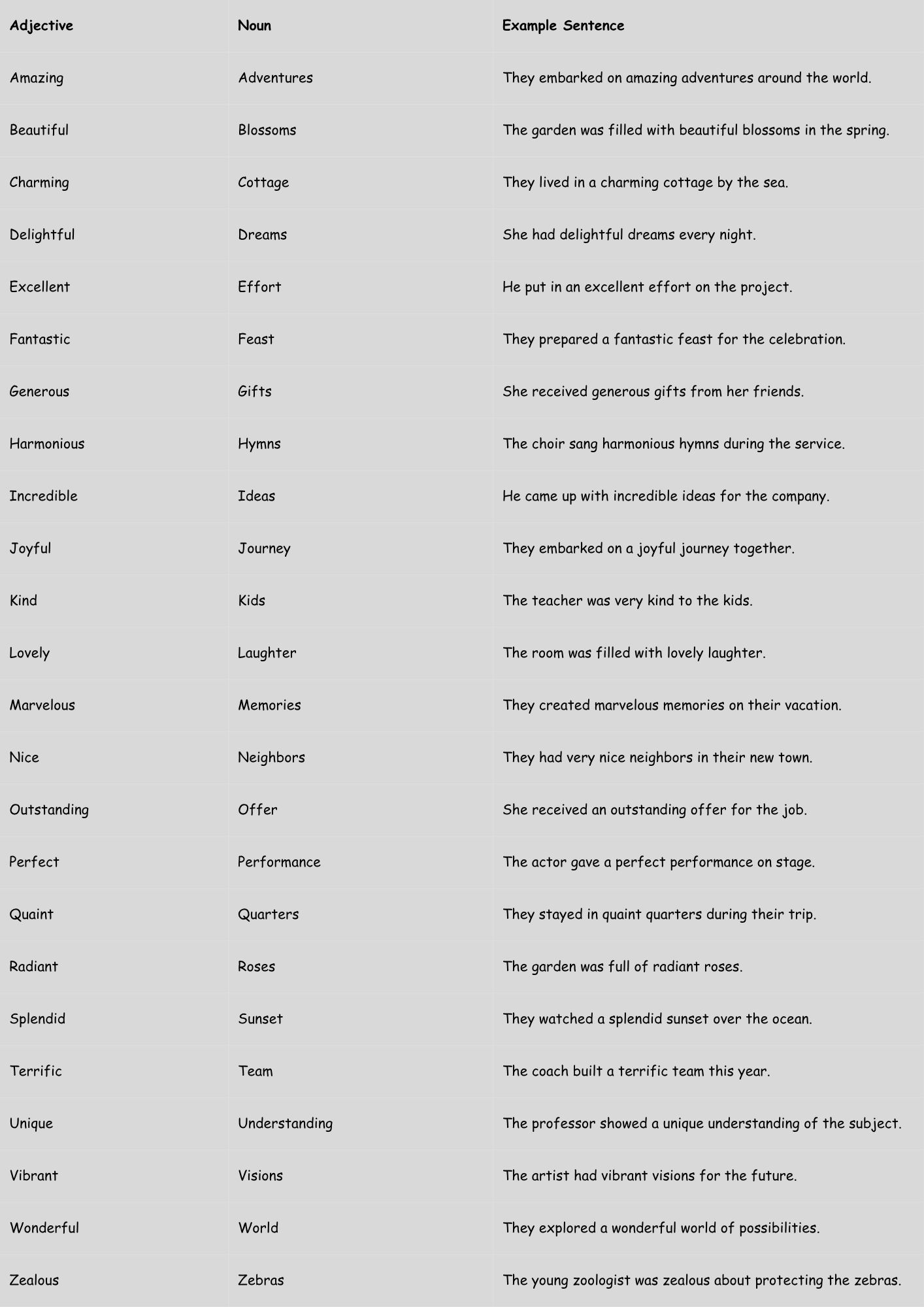
Negative Adjectives
Negative adjectives impart unfavorable qualities to the noun they modify. Using them in alliteration can create a sense of unease, tension, or disapproval.
The table below contains examples of negative adjectives used in alliteration with nouns.
| Adjective | Noun | Example Sentence |
|---|---|---|
| Awful | Accident | They witnessed an awful accident on the highway. |
| Bad | Behavior | The child displayed bad behavior in class. |
| Cruel | Comments | She made cruel comments about his appearance. |
| Dreadful | Disease | The town was struck by a dreadful disease. |
| Evil | Emperor | The evil emperor ruled with an iron fist. |
| Filthy | Flies | Filthy flies swarmed around the garbage. |
| Ghastly | Ghosts | They told stories about ghastly ghosts in the old house. |
| Horrible | Hurricane | A horrible hurricane devastated the coast. |
| Icky | Insects | The forest floor was covered in icky insects. |
| Jealous | Jealousy | His jealous jealousy consumed him. |
| Kniving | Knights | The kniving knights plotted against the king. |
| Lousy | Lies | He told lousy lies to cover up his mistake. |
| Malicious | Myths | The story included malicious myths about the gods. |
| Nasty | Nightmare | She had a nasty nightmare that kept her awake. |
| Offensive | Odor | There was an offensive odor coming from the garbage. |
| Painful | Punishment | He received a painful punishment for his crime. |
| Quarrelsome | Queens | The quarrelsome queens were always fighting. |
| Rotten | Rats | Rotten rats infested the abandoned building. |
| Scary | Shadows | Scary shadows danced in the moonlight. |
| Terrible | Typhoon | A terrible typhoon hit the island. |
| Ugly | Umbrella | She carried an ugly umbrella to protect herself from the rain. |
| Vicious | Villains | The movie featured vicious villains. |
| Wicked | Witch | The wicked witch cast a spell on the prince. |
| Worthless | Waste | The project turned out to be a worthless waste of time. |
Descriptive Adjectives
Descriptive adjectives provide factual or sensory details about the noun they modify. Using them in alliteration can create a vivid and engaging image in the reader’s mind.
The table below contains examples of descriptive adjectives used in alliteration with nouns.
| Adjective | Noun | Example Sentence |
|---|---|---|
| Bright | Buttons | The clown wore a jacket with bright buttons. |
| Blue | Berries | They picked blue berries in the forest. |
| Crimson | Curtains | The room had crimson curtains that blocked the light. |
| Damp | Dirt | The garden was covered in damp dirt. |
| Elegant | Emeralds | She wore elegant emeralds around her neck. |
| Fuzzy | Fabric | The blanket was made of fuzzy fabric. |
| Golden | Gears | The intricate clock had golden gears. |
| Heavy | Hammer | He used a heavy hammer to drive the nails. |
| Icy | Icicles | Icy icicles hung from the roof. |
| Jumbo | Jets | Jumbo jets soared through the sky. |
| Keen | Knives | The chef used keen knives to chop the vegetables. |
| Lavender | Lilies | The bouquet contained lavender lilies. |
| Metallic | Mirrors | The spaceship had metallic mirrors. |
| Nimble | Needles | The seamstress used nimble needles to sew the dress. |
| Orange | Orchards | They visited orange orchards in the countryside. |
| Purple | Paint | She used purple paint to decorate the room. |
| Quiet | Quarters | They found quiet quarters in the library. |
| Round | Rubies | The crown was adorned with round rubies. |
| Silver | Stars | Silver stars twinkled in the night sky. |
| Tiny | Tractors | The farm had several tiny tractors for small tasks. |
| Unusual | Urns | The museum displayed unusual urns from ancient civilizations. |
| Velvet | Violets | She wore a dress with velvet violets embroidered on it. |
| White | Waves | White waves crashed against the shore. |
| Yellow | Yachts | The harbor was filled with yellow yachts. |
| Zigzag | Zones | The map showed zigzag zones of different climates. |
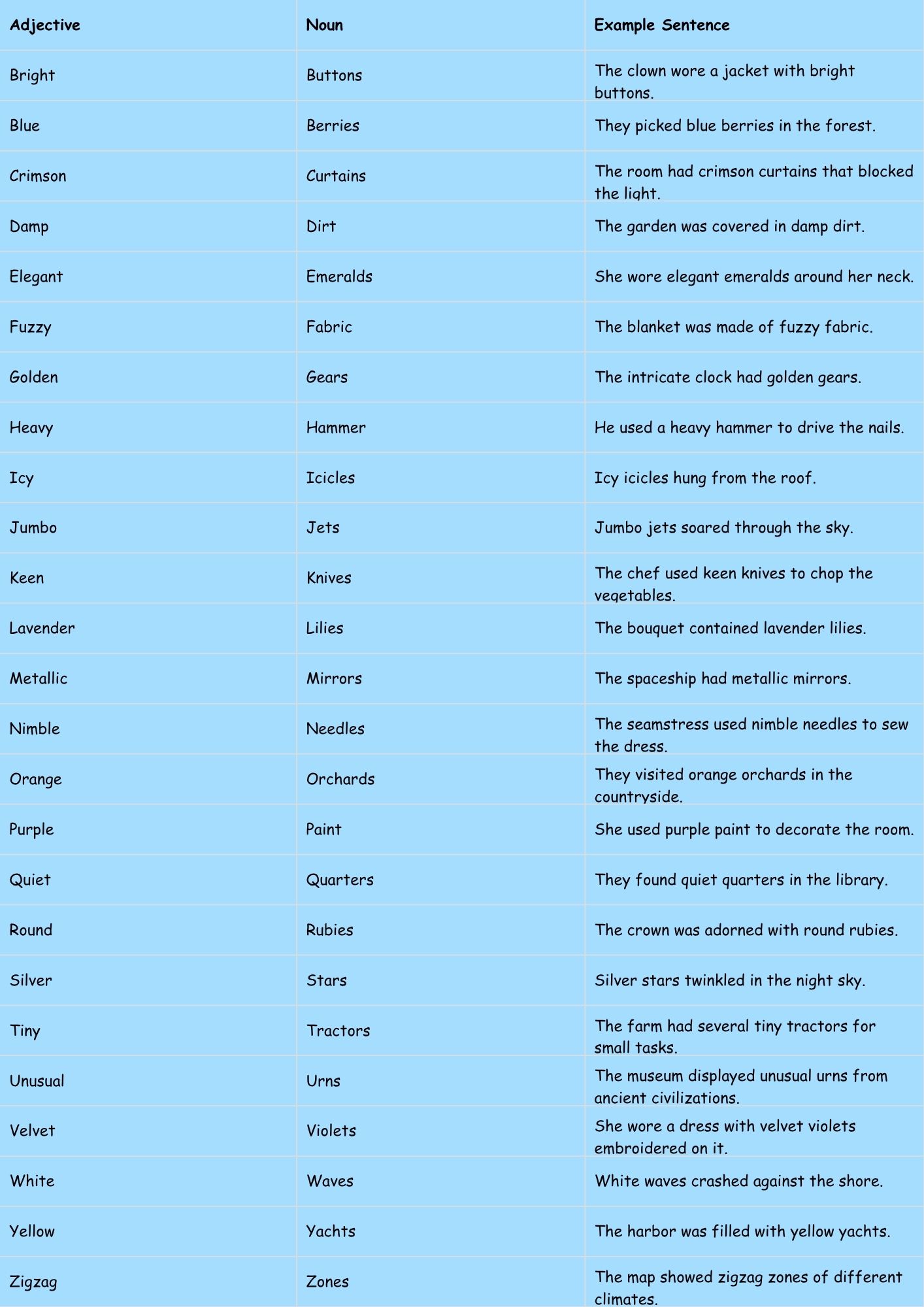
Usage Rules and Guidelines
While alliteration can be a powerful tool, it’s important to use it judiciously. Overuse can make your writing sound forced or contrived. Here are some guidelines to follow:
- Use sparingly: Alliteration should be used to emphasize a point or create a specific effect, not as a constant feature of your writing.
- Vary the placement: Don’t always use the adjective-noun structure. Experiment with different arrangements to keep your writing fresh.
- Consider the context: Alliteration is more appropriate in some contexts than others. It’s often used in poetry, advertising, and speeches, but may be less suitable for formal academic writing.
- Focus on clarity: The alliteration should not come at the expense of clarity. Choose words that fit the meaning and tone of your writing.
- Pay attention to sound: The repeated sounds should be pleasing to the ear. Avoid combinations that are awkward or difficult to pronounce.
Remember that the goal is to enhance your writing, not to distract from it. When used effectively, alliteration can add a touch of artistry and memorability to your work.
Common Mistakes to Avoid
Several common mistakes can diminish the effectiveness of alliteration. Being aware of these pitfalls can help you avoid them and create more polished and impactful writing.
- Forcing alliteration: Choosing words solely for their alliterative quality, even if they don’t fit the meaning or tone of the sentence.
- Overusing alliteration: Using alliteration too frequently, making the writing sound repetitive and unnatural.
- Ignoring sound quality: Selecting words that create an awkward or unpleasant sound when combined.
- Misusing letters: Confusing letters that look similar but sound different (e.g., using “c” and “k” interchangeably when they don’t produce the same sound).
- Neglecting context: Using alliteration in inappropriate settings, such as formal academic writing where it may seem out of place.
Here are some examples of common mistakes and corrections:
| Incorrect | Correct | Explanation |
|---|---|---|
| Crazy cars crashed. | Speeding cars crashed. | “Crazy” doesn’t fit the context as well as “speeding,” which implies reckless driving. |
| Pretty, perfect, precious presents. | Pretty, perfect presents. | Three alliterative adjectives are excessive and sound unnatural. |
| Sharp shapes shimmer. | Sleek shapes shimmer. | “Sharp” and “shapes” create an awkward sound combination. |
| Kindly cats. | Cute cats. | “Kindly” is a great word, but here “Cute” is a better fit. |
| Fantastic Fridays are fun. | Fridays are fantastic. | Alliteration is out of place in a formal essay. |
Practice Exercises
These exercises will help you practice using adjectives for alliteration. Each exercise focuses on a different aspect of alliteration and adjective usage.
Exercise 1: Identifying Alliteration
Identify the alliterative phrases in the following sentences.
- The sly snake slid silently through the grass.
- She sells sea shells by the sea shore.
- Peter Piper picked a peck of pickled peppers.
- The bright balloon floated away.
- Katie’s kitten knocked over the lamp.
- The wild winds whistled through the trees.
- He ate a hearty and healthy breakfast.
- The clever cook created a delicious meal.
- The tiny turtle took its time crossing the road.
- The fast fox fled into the forest.
Answer Key:
- sly snake slid silently
- sea shells, sea shore
- pickled peppers
- bright balloon
- Katie’s kitten knocked
- wild winds whistled
- hearty and healthy
- clever cook created
- tiny turtle took
- fast fox fled
Exercise 2: Completing Alliterative Phrases
Complete the following phrases by adding an adjective that alliterates with the given noun.
- _____ flowers
- _____ trees
- _____ clouds
- _____ stars
- _____ books
- _____ songs
- _____ dreams
- _____ houses
- _____ games
- _____ jokes
Answer Key (Possible Answers):
- Beautiful flowers
- Tall trees
- Calm clouds
- Shining stars
- Big books
- Silly songs
- Deep dreams
- Huge houses
- Fun games
- Jolly Jokes
Exercise 3: Creating Alliterative Sentences
Create a sentence using alliteration with the following words.
- Happy, horses
- Brave, boys
- Silly, snakes
- Clever, cats
- Wonderful, women
- Delightful, dogs
- Fantastic, friends
- Graceful, girls
- Jolly, jesters
- Kind, kids
Answer Key (Possible Answers):
- Happy horses galloped through the field.
- Brave boys explored the forest.
- Silly snakes slithered in the sun.
- Clever cats caught the mice.
- Wonderful women worked together.
- Delightful dogs played in the park.
- Fantastic friends had a picnic.
- Graceful girls danced on stage.
- Jolly jesters joked with the king.
- Kind kids helped their neighbors.
Advanced Topics in Alliteration
For advanced learners, there are several more complex aspects of alliteration to explore.
- Subtle Alliteration: Using alliteration in a subtle way, where the repeated sounds are less obvious but still contribute to the overall effect.
- Combining Alliteration with Other Devices: Integrating alliteration with other literary devices, such as assonance, consonance, and metaphor, to create richer and more complex writing.
- Alliteration in Different Languages: Exploring how alliteration is used in other languages, and how it can be translated effectively.
- The Psychology of Alliteration: Understanding the psychological effects of alliteration, such as its impact on memory and attention.
Mastering these advanced topics will allow you to use alliteration with greater skill and sophistication, creating writing that is both beautiful and impactful.
Frequently Asked Questions
- What is the main purpose of using alliteration?The main purpose of using alliteration is to create a musical effect, emphasize certain words, and make phrases more memorable. It adds a layer of artistry and can enhance the impact of your writing or speech. Alliteration can also draw attention to specific ideas or themes within a text, making them more prominent and engaging for the audience. It is also used to create rhythm and flow, particularly in poetry and prose.
- Can alliteration be used in any type of writing?While alliteration can be used in various types of writing, it is more commonly found in creative writing, such as poetry, fiction, and advertising. It can also be effective in speeches and presentations. However, it is generally less appropriate for formal academic writing, where clarity and precision are paramount. The context and purpose of the writing should guide the decision to use alliteration.
- How much alliteration is too much?The amount of alliteration that is considered “too much” depends on the context and the desired effect. Overusing alliteration can make your writing sound forced, unnatural, and distracting. A good rule of thumb is to use alliteration sparingly, only when it enhances the meaning or impact of the phrase. If the alliteration draws attention away from the message, it is likely being overused.
- Does alliteration only involve the first letter of a word?Yes, alliteration typically involves the repetition of the initial consonant sound in closely connected words. While internal alliteration (repetition of sounds within words) and other sound devices like assonance (repetition of vowel sounds) and consonance (repetition of consonant sounds anywhere within words) exist, the most common and recognizable form of alliteration focuses on the beginning of words.
- What if I can’t find an adjective that alliterates well with my noun?If you’re struggling to find an adjective that alliterates well with your noun, consider rephrasing the sentence or choosing a different noun. The goal is to create a phrase that is both alliterative and meaningful. Sometimes, the best solution is to simply avoid alliteration altogether if it compromises the clarity or quality of your writing. Brainstorming a list of synonyms for either the adjective or the noun can often help you discover a more suitable combination.
- Is it okay to use alliteration even if the words don’t start with the exact same letter, but the same sound?Yes, it is perfectly acceptable to use alliteration where the words start with different letters but produce the same sound. This is because alliteration is based on the repetition of sounds, not necessarily letters. For example, the phrase “cute kittens” is alliterative because “c” and “k” produce the same /k/ sound. The focus should always be on the auditory effect rather than the visual appearance of the letters.
- Can alliteration be used in names?Yes, alliteration is commonly used in names, both for people and for brands. Alliterative names are often more memorable and pleasing to the ear. Examples include “Mickey Mouse,” “Ronald Reagan,” and brands like “Coca-Cola” and “Best Buy.” This technique is frequently employed in marketing and branding to create a strong and lasting impression.
- Are there any languages where alliteration is more common than in English?Yes, alliteration is a prominent feature in many languages, particularly those with strong oral traditions or poetic forms. Old English poetry, for example, heavily relied on alliteration as a structural element. Similarly, alliteration is frequently used in Sanskrit and other ancient languages. While the prevalence of alliteration varies across languages and cultures, it remains a versatile and widely used literary device globally.
Conclusion
Mastering the use of adjectives for alliteration is a valuable skill for anyone looking to enhance their writing and communication. By understanding the principles of alliteration, exploring different types of adjectives, and practicing their application, you can create phrases that are not only descriptive but also memorable and engaging. Remember to use alliteration judiciously, focusing on clarity and sound quality.
As you continue to explore the art of alliteration, experiment with different combinations of adjectives and nouns, and pay attention to the effect they create. With practice, you’ll develop a keen ear for alliterative phrases and be able to use them effectively to add emphasis, rhythm, and artistry to your writing. Embrace the power of sound and let your words resonate with your audience.

